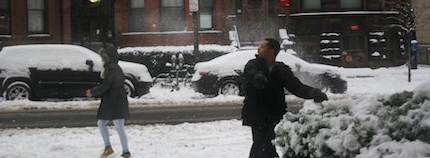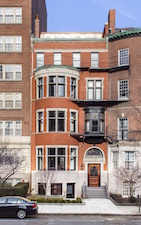Alpha Theta Sigma Chi
The Oldest Continuous Fraternity at MIT
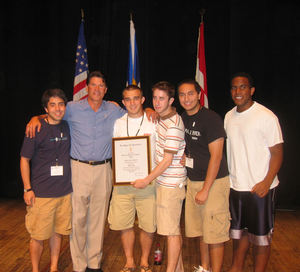
Besides being one of the largest international fraternities in North America, Sigma Chi has had a long history of excellence at MIT that began in 1882. Founded in 1882, the Alpha Theta chapter is the oldest continuous Fraternity at MIT with one of the oldest houses as well (some organizations, such as MIT Libraries, simply cite us as the first MIT fraternity). With nearly 125 pledge classes that have gone through Alpha Theta, our alumni are found in all parts of the world and still enjoy coming back to the house for some of our house's events such as our annual Alumni Day.
A brief history of MIT fraternities, penned by the former secretary of the MIT alumni association, the late Richard A. Knight MIT '47, can be found here.
A History of Alpha Theta Sigma Chi
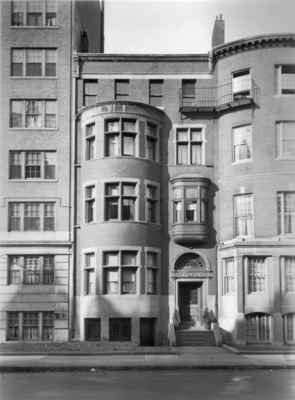
The Massachusetts Institute of Technology was originally conceived to fill the need for a technical school with status equal to a liberal arts college. However, like all technical institutions of the day, MIT drew almost all of its students from local communities, rather than from a regional or national area. As a result, no effort was made to house the students.
Times were changing however, and soon Boston Tech, then located at Boylston and Berkeley Streets, became nationally known. Students came from all sections of the country, but MIT still did not consider student welfare its responsibility.
Such a situation led to the development of fraternities. After an unsuccessful attempt to establish a local fraternity at MIT in the fall of 1881, two of the originators met some members of the Omega chapter of Sigma Chi at a football game over Thanksgiving, and discussed fraternities with them. The result was that on March 21, 1882, Orlo D. Skinner and William B. Meyers, of Phi chapter, Lafayette, installed the first permanent fraternity on the MIT campus. It was the first Sigma Chi chapter in New England, and the forty fourth of the present International Fraternity. The ten founders, in order of initiation, were:
- Herbert F. Bardwell
- Winthrop Alexander
- Frederick O. Harriman
- Edgar C. Hillyer
- Henry F. Baldwin
- Frank F. Johnson
- T. Coleman DuPont
- Robert B. Moore
- Charles A. Herpic
- Daniel A. Campbell
The first meetings were held in the rooms of the members but in November of 1882 they changed to Berkeley Hall. In 1886 they leased a suite of apartments near the Institute. 1887 saw a move to Oxford Terrace; 1888, the Hotel Clifton. In 1890, Sigma Chi moved to an apartment on Huntington Avenue. In 1902, they moved to 1067 Beacon Street, Brookline.
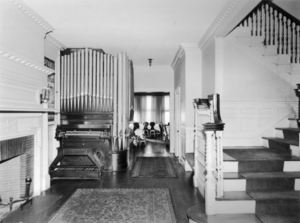
When the United States entered the First World War, the fraternity house closed down, all students having been drafted, and then sent back to school in uniform. A few weeks after the Armistice, the brothers reassembled and rented rooms in the old Fritz-Carleton Hotel on Boylston Street. This location was unsatisfactory, but soon a house was found which had been unoccupied for years. It was located at 532 Beacon Street.
On January 1, 1919, Sigma Chi leased 532 Beacon St. from the heirs of Francis W. Kittredge, a prominent Boston lawyer and politician, for whom the house was originally built. On May 1, 1924, the chapter purchased the house for $40,000 (a shade under $520,000 in 2006 dollars) -- they had raised $28,000 from alumni over the last 15 years, and took out a loan to pay the rest. The three original house Trustees were Dr. Henry M. Chase, George M. Angier, and John Bruce McPherson. The house was complete with pipe organ, and was unique in the fraternity world until its removal in the late 1930's in the World War II scrap drives. The famed opera star, Madame Ernestine Schumann-Heink, once sang in the house when she visited her son Henry Heink, class of 1910. Numerous others among the near-great have tread the halls of 532 Beacon.
More importantly, however, than any of these details of our chapter's development are the achievements of our alumni. Apart from those names we know so well, there have been literally scores of Alpha Theta Sigs who have contributed mightily to their field, and to the community as a whole. We should not however feel that this imparts a benediction upon us. Rather we should realize that this obligates us to live to the fullest of our abilities. Some of these alumni include:
"He [Bob Swanson] started at MIT in 1965 [...]. He was a sociable and generous young man and fitted in well with the Sigma Chi fraternity; he credits his frat brothers with helping him pass his exams. 'I learned not to be afraid of science or very complex problems. Probably the two most important things that came out of those early years were tackle things one at a time and manage your time.' He ended his fourth year with all A's and a prize in chemistry."
- Harold Evans, They Made America
- Thomas Coleman DuPont, '85 - Alpha Theta founder; President DuPont Chemical 1902 - 1915; US Senator for Delaware
- Alfred Irene DuPont, '86 - Credited with saving DuPont Chemical with his cousin Thomas Coleman '85; philanthropist
- H. C. Richardson, '07 - Navy's first engineering test pilot, 13th Naval aviator, one of the first recipients of the Naval Cross, and pilot of one of the first transatlantic flights.
- James Reed, '07 - Principal construction manager for the Golden Gate Bridge in San Francisco
- Houghton H. Whithed, '10 - Constantine Sig
- Alden "Bat" Thresher, '18 - MIT Professor of Economics; Director of MIT admissions from 1936 - 1961
- Edward S. Farrow, '20 - Sigma Chi Grand Consul 1957 - 1959; Constantine Sig
- James R. Killian, Jr., '25 - President of MIT 1948 - 1959; first Science Advisor to President Eisenhower 1957 - 1959; Chairman of the Corporation of MIT 1959 - 1971; namesake of Killian Court
- William Carlisle, Jr., '27 - Grand Praetor; Constantine Sig; Dean of the Praetorial College
- Alex d'Arbeloff, '49 - Chairman of the Corporation of MIT 1997 - 2003; Significant Sig; Chair of the Whitehead Institute Board of Directors 2004; Founder of Teradyne
- Henry Schleinitz, '61 - 1960 - 1961 International Balfour Award Winner
- C. Bruce Tarter, '61 - Director of Lawrence Livermore National Laboratory, 1994 - 2002
- Ron Norelli, '67 - Founder of Norelli & Co., Significant Sig
- Kenneth Morse, '68 - Co-Founder of 3COM, Managing Director of the MIT Entrepreneurship Center
- Bob Swanson, '69 - Co-Founder of Genentech
- David B. Ashley, '73 - President, University of Nevada Las Vegas (UNLV); Significant Sig
- John Piotti, '83 - 1983 - 1984 International Balfour Award Winner; Maine House of Representatives; Order of Constantine
- Brian Robertson, '95 - Founder of early social networking site PlanetAll, co-founder of online bond trading firm Visible Markets, CEO of concentrated photovoltaics manufacturuer Amonix, Inc.
- Sam Towell, '00 - 1999 - 2000 International Balfour Award Winner
- Ben Pope, '08 - 2008 - 2009 International Balfour Award Winner
Supplementary Documents
- 1882 MIT Tech announcing chapter formation (page 8)
- Centennial Banquet Packet
- Alden "Bat" Thresher '18 Letter
- Robert Dexter '27 Letter
- Section of the Alpha Theta Bylaws from 1950
- September 1983 Playboy Article on MIT
Beaver Sigs, Annuals
- May 1914 - Alpha Theta Bulletin
- May 1923 - Alpha Theta Annual No. 1
- May 1924 - Alpha Theta Annual No. 2
- May 1925 - Alpha Theta Annual No. 3
- 1941 - Beaver Sig Vol. 1, No. 1
- August 1942 - Beaver Sig Vol. 3, No. 1
- February 1946 - Beaver Sig Vol. 1946, No. 1
- August 1949 - Beaver Sig Alumni Edition
- Fall 1949 - Beaver Sig Rush Edition
- Spring 1952 - Beaver Sig
- Fall 1952 - Beaver Sig
- March 1957 - Beaver Sig
- December 1957 - Beaver Sig
- April 1958 - Beaver Sig
- December 1958 - Beaver Sig
- February 1960 - Beaver Sig
- May 1960 - Beaver Sig
- November 1960 - Beaver Sig
- February 1961 - Beaver Sig
- June 1961 - Beaver Sig
- January 1962 - Beaver Sig
- Spring 1962 - Beaver Sig
- April 1964 - Beaver Sig
- Summer 2000 - Beaver Sig
- February 2001 - Beaver Sig
- June 2001 - Beaver Sig
- Winter 2001 - Beaver Sig
- Summer 2002 - Beaver Sig
- Spring 2003 - Beaver Sig
- Spring 2004 - Beaver Sig
- Late Spring 2004 - Beaver Sig
- Winter 2004 - Beaver Sig
- June 2005 - Beaver Sig
- Winter 2006 - Beaver Sig
- Summer 2007 - Beaver Sig
- Winter 2007 - Beaver Sig
- Spring 2008 - Beaver Sig
- Spring 2009 - Beaver Sig
- June 2009 - Beaver Sig
- Febrary 2010 - Beaver Sig
- June 2010 - Beaver Sig
- March 2011 - Beaver Sig
- June 2011 - Beaver Sig
- March 2012 - Beaver Sig
- September 2012 - Beaver Sig
- June 2013 - Beaver Sig
- June 2014 - Beaver Sig
- August 2015 - Beaver Sig
- Winter 2016-2017 - Beaver Sig
- Winter 2017-2018 - Beaver Sig
- Spring 2018 - Beaver Sig
- Fall 2018 - Beaver Sig
- Spring 2019 - Beaver Sig
- Fall 2019 - Beaver Sig
- Spring 2020 - Beaver Sig
- Fall 2020 - Beaver Sig
- Spring 2021 - Beaver Sig
- Winter 2021-2022 - Beaver Sig
- Spring 2022 - Beaver Sig
- Fall 2022 - Beaver Sig
- Spring 2023 - Beaver Sig
